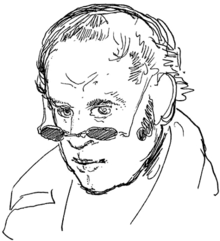Rodolphe Töpffer
| Rodolphe Töpffer | |
|---|---|

Self portrait of Rodolphe Töpffer (1840)
|
|
| Born |
31 January 1799 Geneva, Léman, Helvetic Republic |
| Died | 8 June 1846 (aged 47) Geneva, Switzerland |
| Nationality | Swiss |
| Occupation |
|
Rodolphe Töpffer (31 January 1799 – 8 June 1846) was a Swiss teacher, author, painter, cartoonist, and caricaturist. He is best known for his illustrated books (littérature en estampes, "graphic literature"), which can be seen as the earliest European comics.
Paris-educated, Töpffer worked as a schoolteacher and ran a boarding school, where he entertained students with his caricatures. In 1837, he published Histoire de M. Vieux Bois (published in the United States in 1842 as The Adventures of Obadiah Oldbuck). Each page of the book had one to six captioned cartoon panels, much like modern comics. Töpffer published several more of these books, and wrote theoretical essays on the form.
Töpffer was born on 31 January 1799 in Geneva, Switzerland. His father, painter and occasional caricaturist Wolfgang-Adam Töpffer, had come from Franconia. Rodolphe was educated in Paris from 1819 to 1820, then returned to Geneva and became a school teacher. By 1823 he established his own boarding school for boys. In 1832 he was appointed Professor of Literature at the University of Geneva.
Relatively successful in his profession, Rodolphe gained fame from activities he pursued in his spare time. He painted local landscapes in a style considered influenced by contemporary Romanticism. He wrote short stories and entertained his students by drawing caricatures. He collected these caricatures in books; the first of them, Histoire de M. Vieux Bois ("The Story of Mr. Wooden Head"), was completed by 1827 but not published until 1837. It was 30 pages, each containing one to six captioned panels. It was translated and republished in the United States in 1842 as The Adventures of Obadiah Oldbuck. The stories were reproduced by autography, a variation of lithography that allowed him to draw on specially prepared paper with a pen. The process allowed for a loose line, and was quicker and freer than the more common engraving process.
...
Wikipedia
